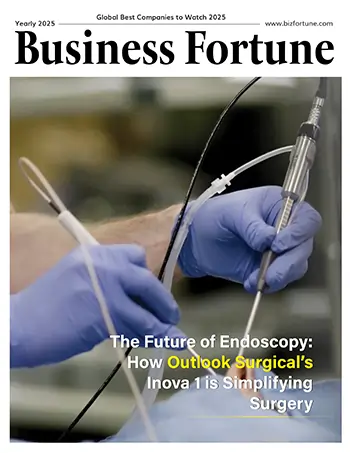Home Industry Nanotechnology How Tiny Tech is Quietly Revol...
How Tiny Tech is Quietly Revolutionizing Mechanical Engineering
Nanotechnology

Business Fortune
18 April, 2025
Nobel laureate and scientist Richard Feynman initially proposed the concept of nanotechnology in 1965. The main drivers of nanotechnology have been leveraging the advantages of material shrinking and exploring the potential for creating even more enticing, smaller technologies in the future. The study and use of atomic or molecular-scale issues is known as nanotechnology, and it frequently incorporates ideas from a wide range of scientific disciplines, including biology, chemistry, physics, engineering, and medicine. This information is necessary for the creation, synthesis, characterization, and application of nanomaterials and nanodevices. The "nanoscale," or 1 to 100 nm, word describes the spectrum of regularly used nanotechnology.
These tiny particles have the ability to control individual molecules and atoms. Materials exhibit better cell functioning when analyzed at the nanoscale as opposed to the micro or macroscale. The matter changes its behavior as its dimensions shrink to the nanoscale due to the effects of quantum size, which shows that specific atoms' or molecules' behaviors become more prominent than the particle's nanoscale level when compared to the atomic or molecular behaviors of the particle as a whole.
In mechanical engineering, nanotechnology has also significantly changed the design and production procedures. Engineers are now able to precisely construct sophisticated and complicated structures because of nanoscale 3D printing. As a result, there are now more possibilities for developing equipment and its components, which improves their reliability and efficiency.
Improving the Durability and Performance of Existing Materials
The strength, usefulness, and durability of the materials now in use are subject to certain limitations. However, by using nanotechnology, these materials may be improved to high-performance materials with superior attributes. This has the potential to disrupt a number of sectors and bring about significant technical improvements. One of the main ways that nanotechnology might improve the durability of current materials is by strengthening them.
By adding nanoparticles like graphene or carbon nanotubes, materials including metals, plastics, and ceramics may become significantly stronger. These nanoparticles improve the material's resilience to wear and mechanical stress by acting as reinforcements and preventing fractures from spreading. They are therefore ideal for application in high-stress environments, such as the aerospace and automotive sectors.
Nanotechnology can enhance a material's functional properties and increase its strength and corrosion resistance. For instance, adding nanoparticles to textiles can improve their resistance to stains and water. As a result, clothing has become self-cleaning and water-resistant. Similar to this, incorporating nanoparticles into building materials like concrete may strengthen them and make them more resilient to environmental factors like water damage and UV radiation.
Optimizing System Design and Energy Consumption with Nanoscale Simulation
The expanding worldwide population and the ensuing need for energy have caused the engineering sector to become more and more worried about energy use. Conventional, energy-intensive mechanical systems and processes employed in industry are responsible for a significant amount of global energy consumption. This is where nanotechnology comes into play, giving mechanical engineers innovative approaches to reduce energy use.
Another way that nanotechnology is helping to lower energy use is through the development of innovative lubricants. In mechanical systems, friction between moving parts results in energy losses. Because of their limited ability to reduce friction, conventional lubricants have a tendency to degrade over time and need to be reapplied often. Nanotechnology has enabled the creation of novel lubricants with enhanced lubricating properties that reduce friction and energy losses. These lubricants also need less frequent maintenance and reapplication since they stay longer.
Additionally, the use of nanotechnology is improving the design and performance of mechanical systems. Engineers may use computer simulations and modeling to build and optimize mechanical systems at the nanoscale level. This makes it possible for them to create systems that are more compact, energy-efficient, and use less power. For example, the use of nanotechnology to create more efficient and smaller automobile engines has reduced carbon emissions and energy usage.
Future Trends in Nanotechnology
Physics, biology, chemistry, and every other field of study have all been swiftly overtaken by nanotechnology. Microscaling is anticipated to have a significant impact on manufacturing technology due to its well-established advantages. Each industry is presently dealing with a brand-new area brought forth by nanotechnology. Examples of these areas in mechanical engineering are energy conservation, nano 3D printing, the creation of sensors and actuators, and performance and durability enhancement. Some of the most significant advances in mechanical engineering's subject of nanotechnology are being produced there, and the materials and mechanical sciences are introducing the most advanced and affordable technologies.
The Transformative Potential of Nanotech
The fast-developing topic of nanotechnology has attracted a lot of interest lately. Its uses are numerous and varied, and it entails the manipulation of matter at the atomic or molecular level. Mechanical engineering is one subject where nanotechnology has demonstrated enormous promise and significance. The design, manufacture, and operation of equipment, structures, and systems are the focus of the field of mechanical engineering. From the invention of steam engines during the Industrial Revolution to the current manufacturing of sophisticated cars and airplanes, it has been instrumental in forming the contemporary world.


































